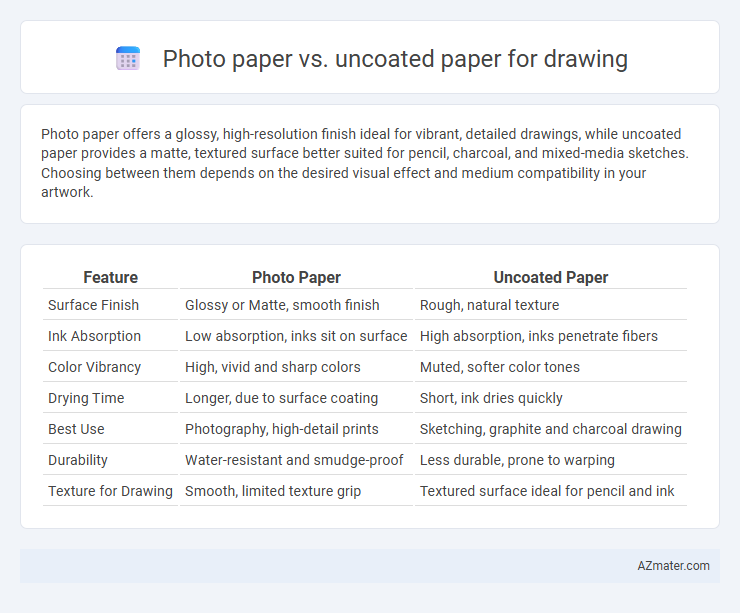Photo paper offers a glossy, high-resolution finish ideal for vibrant, detailed drawings, while uncoated paper provides a matte, textured surface better suited for pencil, charcoal, and mixed-media sketches. Choosing between them depends on the desired visual effect and medium compatibility in your artwork.
Table of Comparison
| Feature | Photo Paper | Uncoated Paper |
|---|---|---|
| Surface Finish | Glossy or Matte, smooth finish | Rough, natural texture |
| Ink Absorption | Low absorption, inks sit on surface | High absorption, inks penetrate fibers |
| Color Vibrancy | High, vivid and sharp colors | Muted, softer color tones |
| Drying Time | Longer, due to surface coating | Short, ink dries quickly |
| Best Use | Photography, high-detail prints | Sketching, graphite and charcoal drawing |
| Durability | Water-resistant and smudge-proof | Less durable, prone to warping |
| Texture for Drawing | Smooth, limited texture grip | Textured surface ideal for pencil and ink |
Introduction: Understanding Paper Types
Photo paper offers a glossy or matte finish optimized for vibrant color reproduction and sharp details, making it ideal for high-quality printed images and artwork. Uncoated paper, with its porous surface, provides excellent ink absorption and a natural texture preferred for sketching, drawing, and mixed media applications. Understanding these paper types helps artists select the right medium to enhance their techniques and final presentation.
What is Photo Paper?
Photo paper is a specially coated paper designed to produce high-resolution, vibrant images with sharp detail and vivid color reproduction, making it ideal for printing photographs and detailed drawings. It features a smooth, glossy, or matte finish that enhances ink absorption and prevents smudging, ensuring longevity and durability of printed artwork. Compared to uncoated paper, photo paper offers superior color accuracy and contrast, essential for professional-quality drawings and photographic prints.
What is Uncoated Paper?
Uncoated paper is a type of drawing surface that lacks the glossy or smooth finish found in photo paper, providing a textured, absorbent quality ideal for pencils, charcoal, and ink. Its porous nature allows for better blending and layering of dry media, making it preferable for sketches and detailed illustrations. Unlike photo paper, uncoated paper is less reflective and more versatile for varied artistic techniques requiring control over shading and line precision.
Surface Texture Comparison
Photo paper features a smooth, glossy surface that enhances color vibrancy and sharp detail, making it ideal for high-resolution photographic prints. Uncoated paper offers a textured, matte finish that provides excellent absorbency and a natural feel, preferred for pencil, charcoal, and pastel drawings requiring rich tonal variation. The tactile contrast between photo paper's sleek surface and uncoated paper's fibrous texture significantly impacts ink absorption and overall artistic expression.
Color Vibrancy and Print Quality
Photo paper delivers superior color vibrancy due to its glossy or satin finish, which enhances ink absorption and sharpness, making prints appear more vivid and detailed. Uncoated paper absorbs ink differently, often resulting in duller colors and less precise lines, affecting overall print quality for drawings. For artists prioritizing rich hues and crisp images, photo paper provides a more professional and visually striking outcome.
Drawing Experience and Medium Compatibility
Photo paper offers a smooth and glossy surface ideal for detailed and vibrant ink or marker drawings, enhancing color saturation and sharpness. Uncoated paper provides a more textured, absorbent surface, suited for dry mediums like graphite, charcoal, and colored pencils, enabling better layering and blending. The choice profoundly impacts the drawing experience, where photo paper may resist layering of wet mediums, while uncoated paper excels in accommodating varied artistic techniques.
Durability and Longevity
Photo paper offers superior durability and longevity for drawing due to its specially coated surface that resists fading, moisture, and smudging, making it ideal for preserving detailed artwork over time. Uncoated paper, while preferred for its texture and absorbency, is more susceptible to wear, discoloration, and damage from environmental factors, reducing the lifespan of the drawing. Choosing photo paper ensures enhanced protection and longevity, especially for high-quality prints and archival purposes.
Cost Differences
Photo paper typically costs significantly more than uncoated paper due to its specialized coating designed for vibrant color reproduction and durability in drawing applications. Uncoated paper offers a more budget-friendly option, ideal for sketches and dry media, but may lack the enhanced texture and finish needed for high-quality photo-like drawings. Artists prioritizing project cost efficiency often prefer uncoated paper, while those demanding premium print quality invest in photo paper despite the higher price.
Best Uses for Each Paper Type
Photo paper excels for vibrant, high-resolution prints and detailed photographic reproductions, making it ideal for professional photo displays, greeting cards, and art prints requiring sharp color accuracy. Uncoated paper offers a natural texture and superior ink absorption perfect for pencil, charcoal, and pastel drawings, providing artists with enhanced control and a matte finish that reduces glare. Choosing between photo paper and uncoated paper depends on whether the project demands vivid color vibrancy or textured surface properties for traditional media techniques.
Choosing the Right Paper for Your Artwork
Photo paper offers a smooth, glossy surface ideal for vibrant color reproduction and sharp detail, making it suitable for photographic prints and digital artwork. Uncoated paper provides a textured, absorbent surface favored by artists for drawing with pencils, charcoal, and ink, as it allows better control and layering of media. Selecting the right paper depends on the drawing medium and desired finish, with photo paper enhancing color intensity and uncoated paper supporting traditional drawing techniques.

Infographic: Photo paper vs Uncoated paper for Drawing
 azmater.com
azmater.com